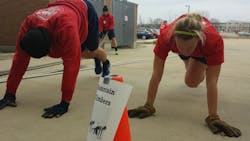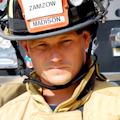Health & Wellness: 6 Tips to Being a Fit Firefighter in 2019
The health and wellness of fire service members has been at the forefront of many conference sessions, magazine articles and department trainings. Yet cancer diagnoses continue to rise, musculoskeletal injuries are high, heart attacks and strokes continue to kill us, and suicide rates are higher than ever. With all this attention and talk, why are we not seeing the results?
The added attention to improving firefighter health is still in its infancy. Although there is significant research being developed and more and more departments are crafting standard operating guidelines (SOGs) geared toward improving our health, it’s too early to decipher their true applications and effectiveness. Another issue: Many fire service leaders are more likely to talk about improving health than actually provide resources and funding to make it happen.
This then leads to a major point that every firefighter must take to heart: Regardless of research, leadership and funding, your health and wellness are mainly determined by your actions. You have the power to not only make positive changes in your health but also to help make positive changes in the fire service. How? Lead by example to be the healthy and fit firefighter on your crew. Here are six actions to get you started.
1. Stay hydrated
Around most firehouses, the day and the shift usually start with some coffee. We all need a pick-me-up from time to time, but before you reach for that second cup, have some water. Water is the center of all metabolic processes, so the more hydrated you are, the better you will perform.
Progressive dehydration from exercise (or fireground operations) impairs performance, mental capacity and perception of effort, and it can be life-threatening. With as little as a 2 percent body water shortage, the ability to perform a high-intensity activity can be greatly impaired. On the fireground, reduced performance can lead to death or injury to you or a crewmember.
Try to drink at least 64 ounces of water per day. Carry a water bottle around the station and on the rig to help ensure that you are getting enough. Others may follow suit.
2. Eat like an athlete
Firefighters, EMTs and paramedics are fire-rescue athletes. We need to fuel our bodies just like we do our trucks and equipment. As such, it’s important to ensure that fuel is quality fuel.
Try to consume whole foods that lack artificial sweeteners and preservatives. Create habits to consume lean proteins like fish and chicken, eat leafy vegetables that have good fiber, and avoid foods that are high in sugars.
Prepare healthy meals and keep the processed cakes and cookies out of the kitchen to avoid those late-night temptations. If you’re the cook in your firehouse, always have healthy alternatives available like a salad and vegetables. I know cooking is difficult for a group of hungry first responders. Let’s be honest, you’re going to get criticism regardless of what you cook; you might as well make it healthy.
Additionally, always have some healthy snacks on hand. Health snacks like bananas and nuts will help you avoid the sugary temptations while staying fueled during busy shifts. The right food will give you the proper energy to tackle whatever challenges may come your way.
3. Get moving
Fire and rescue scenes are very physically demanding. A well-rounded and consistent fitness program can help you meet the demands of the job physical and mentally. Consistent workouts that incorporate mobility, core strength and cardiovascular exercises can reduce the chances of injury and help maintain a healthy weight, and the endorphins released can rid the body of toxins and help manage stress.
- 5 Exercises Every Firefighter Needs to Do
- 6 Bodyweight Exercises for Firefighters
- Creating a Fire-Rescue Workout Program
Aim to work out at least three to four times (at a minimum) per week and create a plan to schedule time to exercise around shifts and other responsibilities. If you are concerned about exhausting your energy with a workout on shift, consider working on some light cardiovascular activity and focus on improving your mobility with some stretching, yoga and foam rolling.
4. Manage your stress
Firefighting is one of the most stressful occupations. Unmanaged stress can have serious long-term detrimental effects on health. Chronic stress that’s left unchecked can contribute to mental health problems, such as anxiety and depression, as well as physical health problems, such as high blood pressure and a weakened immune system. Chronic stress has also been shown to lead to job dissatisfaction and subsequent burnout.
It is vital to find ways to manage stress. Some common, yet flawed, ways we deal with stress include alcohol, drugs, overeating and even sarcasm. There are healthier alternatives. Learn to identify your triggers and find ways to deal with these triggers in a positive manner.
Some positive ways to deal with stress include meditation, relaxation and yoga. You may hesitate, but yoga has a long list of benefits to help the body physically unwind. Another way to cope is to make sure you are getting a quality night’s rest whenever possible. I know this is sometimes difficult while on shift, but do not let yourself go too long without getting rest. Find ways to recover while off shift. Some tips to help your mind and body relax: Stay away from caffeine and other stimulants before going to bed, and create a cool, calm and dark sleeping environment.
5. Clean you gear regularly and wear your SCBA
Many firefighters still take pride in wearing heavily soiled and well-worn personal protective clothing. Don’t be that person. Science and research have proven that contaminated turnout gear will off-gas toxic, cancer-causing materials that can be inhaled or absorbed through the skin. Keeping clothing clean and properly maintained is not only a way to extend the life of the gear but that of yourself and your crew.
Make sure you follow the NFPA and manufacturer’s instructions for gear cleaning and care. Do routine cleanings after any emergency response where soiling has occurred. And, most importantly, wear your SCBA during any and all calls where smoke is visible. This includes overhaul and especially during dumpster and automobile fires. Out of everything that we wear, the SCBA provides the highest level of protection—unless we don’t use it.
6. Change the culture!
If you have been a member of the fire service for some time, you have probably heard and witnessed firsthand the expression that the fire service is 150 years of tradition, unimpeded by progress. While this may be humorous, it also has some amount of truth associated with it.
One of the things that is impairing our progress in firefighter health and wellness is our culture. Most firehouses have donut spreads that would make police officers jealous and fully equipped gyms that are underutilized. We all play a role in changing the culture. Some small actions can go a long way to make positive change.
Focus on changing your own health, and invite and challenge others to do the same. Create some workouts for you and your crew, develop field trainings that require a component of fitness, and make sure to provide healthy nutritional options around the firehouse. If you are a chief or in a position of rank, hold yourself accountable and set the example. Then, hold others accountable for their health. Most importantly, we all need to start devoting some of our time and resources to educating each other about health-related issues.
In sum
Be the change you wish to see in the fire service. Change your own health by staying hydrated, eating like an athlete, working out regularly, always wearing your SCBA and having clean gear, and learning how to manage your stress in more healthy manners. When we make a significant and lasting change in what we do, we tend to change our attitudes to match our actions. Be the positive example, and encourage others to do the same. I love the fire service, and if you are reading this, I imagine you do, too. Remember, our fire service culture is not determined by our “talk”; it’s displayed in our actions.
Resources
Freeman, P. “PPE: Clean, Maintain & Store.” Firehouse Magazine. October 2016. Firehouse.com/12244734.
LeDuc, T, Henderson, S, Masias, S, et al. “How Firefighters Can Manage Stress.” Firehouse Magazine. February 2016. Firehouse.com/12152154.
Zamzow, A. “The State of Fitness in the Fire Service.” Firehouse Magazine. December 2017. Firehouse.com/12378054.
About the Author
Aaron Zamzow
Aaron Zamzow is a firefighter/training officer for Madison, WI, Fire Department. He holds a bachelor’s degree in health/wellness and has 20 years of experience as a fitness trainer. He created Fire Rescue Fitness and authors programs that are aimed at getting fire rescue athletes fit for duty.

